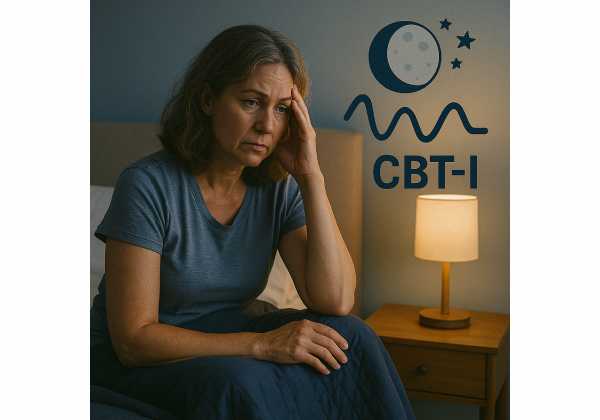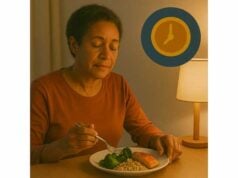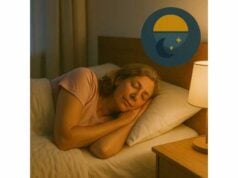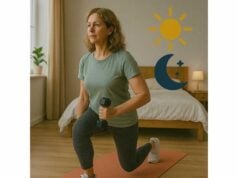
Sleeplessness in midlife can creep in quietly—more nighttime awakenings, earlier alarms from your brain, and a cycle of worry that drains energy the next day. Cognitive Behavioral Therapy for Insomnia (CBT-I) is the most evidence-backed, skills-based approach to break that pattern. It rebuilds the link between bed and sleep, recalibrates sleep pressure with a time-limited “sleep window,” and updates unhelpful beliefs about rest. This guide gives you a clear, practical path to start CBT-I safely at home, with exact steps, guardrails, and a two-week schedule you can follow. We will also show when to add circadian supports (light, activity, meal timing) and when to ask your clinician about medical causes or a sleep study. If you want the broader context on how recovery habits add up across the lifespan, explore our concise hub on sleep, stress, and recovery for longevity.
Table of Contents
- Identify Your Insomnia Type: Onset, Maintenance, and Early Awakening
- Stimulus Control: Rebuilding the Bed Sleep Connection
- Sleep Restriction and Sleep Window: How to Apply It Safely
- Cognitive Techniques: Worry Time, Thoughts, and Expectations
- Circadian Supports: Light, Activity, and Meal Timing
- A Two Week CBT-I Plan You Can Follow
- When to Seek Medical Care or a Sleep Study
Identify Your Insomnia Type: Onset, Maintenance, and Early Awakening
Before changing anything, define the problem with precision. Three patterns dominate:
- Sleep-onset insomnia: You climb into bed and feel tired, but your brain will not “hand over the keys.” You may lie awake for 30–90 minutes (or more), replaying the day or planning tomorrow.
- Sleep-maintenance insomnia: You fall asleep, then wake at 1–3 a.m. and cannot settle. Sometimes you drift in and out until morning; other times you feel alert immediately.
- Early-morning awakening: You wake 60–120 minutes before your target with a sense of “I am done.” Getting back to sleep is hard, even when you still feel sleepy later in the morning.
You can have more than one pattern; track which one dominates this week. Keep a simple sleep log for seven days (bedtime, time you think you fell asleep, awakenings, final rise, naps, alcohol/caffeine timing). Estimate, do not obsess. This baseline lets you tailor CBT-I and measure change.
Also note triggers and maintainers. Triggers often include acute stress, travel, pain, or a life transition (menopause, caregiving). Maintainers are the habits that keep insomnia going: earlier bedtime “just in case,” sleeping in to catch up, dozing on the couch, or staying in bed awake. CBT-I targets the maintainers—because changing them is what restores sleep pressure and confidence.
Finally, check safety and fit. If you operate heavy machinery, have uncontrolled seizure or bipolar disorder, or face high fall risk at night, adapt the plan with a clinician. Lightheadedness when sleep deprived is real; move slowly if you get up at night and keep a small, low-glare nightlight on the path to the bathroom.
Stimulus Control: Rebuilding the Bed Sleep Connection
Stimulus control retrains your brain to associate the bed only with sleep and intimacy. It is simple, powerful, and often the fastest-acting piece of CBT-I.
Core rules
- Go to bed only when sleepy. Sleepy means heavy eyelids and head nods—not just “tired of the day.”
- Use the bed only for sleep and intimacy. No scrolling, email, TV, or work. Reserve wakeful activities for a chair or another room.
- If you cannot sleep, get up. After about 15–20 minutes (do not clock-watch; use your sense), leave the bed. Do something quiet and low-light—read paper pages, fold laundry, listen to calming audio—then return when sleepy again. Repeat as needed.
- Wake at a fixed time every day. Anchor your final rise time seven days a week. This stabilizes your circadian clock and helps rebuild homeostatic sleep pressure.
- Avoid daytime dozing. If you must nap for safety, keep it brief (≤20 minutes) and before mid-afternoon.
Make it workable at home
- Set a “calm corner.” Keep a blanket, paper book, dim lamp, and headphones ready outside the bedroom.
- Tame light at night. Use warm, low-lumen bulbs and reduce screen brightness; light exposure undermines the sleepy signal. For practical screen and bulb changes that preserve melatonin, see our guide to evening light hygiene.
- Shrink decision fatigue. Pre-decide two or three low-stimulation activities for midnight wakefulness.
What to expect
The first few nights can feel odd—more trips out of bed, a bit more daytime sleepiness. That is a feature, not a bug; stimulus control quickly erodes the habit of lying awake in bed, the main maintainer of insomnia. Within a week, many people notice faster sleep onset and fewer prolonged awakenings. Track progress with a simple sleep efficiency metric (total sleep time ÷ time in bed × 100).
Sleep Restriction and Sleep Window: How to Apply It Safely
“Sleep restriction” is better named sleep window: you temporarily limit time in bed to match realistic sleep time, then expand as sleep deepens. The aim is to raise sleep pressure and reduce wakefulness in bed.
Step-by-step
- Calculate your baseline. From your 7-day log, estimate average total sleep time (TST). Example: in bed 8 hours, asleep about 5.5 hours on average.
- Set the initial window. Start with TST + 30–60 minutes, not less than 5.5 hours for safety. In the example, 6.0–6.5 hours.
- Fix your wake time. Choose a realistic, consistent final rise (e.g., 6:30 a.m.). Work backward to set bedtime (e.g., 12:00 a.m. for a 6.5-hour window).
- Hold the window for 5–7 nights. Follow stimulus control inside the window. No early bed “make-ups.”
- Adjust weekly by sleep efficiency (SE).
- If SE ≥ 85–90% for the last 3–4 nights with tolerable sleepiness, add 15–30 minutes (earlier bedtime).
- If SE 80–84%, hold steady.
- If SE < 80%, subtract 15–30 minutes (later bedtime).
- Stop when you reach your sweet spot. Most people stabilize with SE 85–90% and 7–8 hours in bed.
Safety notes
- Expect sleepiness the first week. Avoid drowsy driving; stand, move, or delay departure if you feel heavy-eyed.
- Keep caffeine earlier in the day; do not use it to push through unsafe fatigue.
- If you have bipolar disorder, uncontrolled seizures, untreated sleep apnea, or significant fall risk, use a gentler window with clinician oversight.
Why it works
By matching time in bed to realistic sleep, you convert fragmented 8 hours into consolidated 6–7 hours, then build back up. This strengthens a tidy pattern: faster sleep onset, fewer long awakenings, and deeper slow-wave sleep. For a deeper dive on how sleep architecture improves with good process, see our overview of deep and REM targets.
Cognitive Techniques: Worry Time, Thoughts, and Expectations
CBT-I is not just schedules; it also updates the stories you tell yourself about sleep. Three tools matter most.
1) Worry time (scheduled problem-solving)
Set a 15–20 minute appointment late afternoon or early evening to capture “open loops.” Write each worry or task, then list the next concrete step (email X, print form, set alarm). Park the list. When worries surface at night, remind yourself, “I have a slot reserved tomorrow.” This approach reduces bedtime rumination without suppressing thoughts.
2) Cognitive defusion and balanced expectations
Swap absolutes (“If I do not sleep 8 hours, tomorrow is ruined”) for accurate ranges (“I function at 80–90% with 6.5–7.5 hours; I can still handle essentials”). Practice noticing catastrophic thoughts and answering them with brief, factual alternatives. Aim for credible, not “positive.”
3) Attention training and wind-down
Ten minutes of exhale-biased breathing (e.g., inhale 4, exhale 6) quiets arousal and creates a bridge from day to night. If your mind is busy, allow thoughts to pass while keeping attention on the rhythm of your breath or a simple body scan.
Helpful scripts
- “My job is to create conditions, not to force sleep.”
- “Awake time in bed teaches my brain to be alert here; leaving the bed protects sleep.”
- “Good nights return when I follow the plan, even if tonight feels choppy.”
If you want a gentle companion practice to calm the stress response alongside CBT-I, explore simple mindfulness skills that steady the HPA axis.
Circadian Supports: Light, Activity, and Meal Timing
Your body clock sets the phase for sleepiness and alertness. Aligning light, movement, and meals makes CBT-I work faster.
Light
- Morning: Get 5–30 minutes of outdoor light within an hour of waking (longer on dark days). This helps anchor melatonin timing for the coming night.
- Midday: Take brief daylight breaks to reinforce the day signal.
- Evening: Dim household lights 2–3 hours before bed. Shift screens to warm tone and lower brightness. Avoid bright overheads.
- Night awakenings: Use the least light needed for safety.
Activity
- Daytime movement boosts sleep drive. Aim for 150–240 minutes per week of easy-to-moderate cardio plus 2–3 strength sessions.
- Timing: Finish vigorous workouts at least 3 hours before bedtime. If you must train late, keep it lighter and add a longer cool-down.
Meals and stimulants
- Dinner: Finish 3–4 hours before bed; keep it moderate in size, with familiar foods.
- Late snacks: If a small snack helps with reflux or overnight hunger, choose something bland and light (e.g., yogurt or a small banana).
- Caffeine: Set a cutoff 8–10 hours before bed (10–12 hours if sensitive).
- Alcohol: Keep it earlier and light; alcohol fragments sleep and raises early-morning awakenings.
Temperature
- A slightly cool bedroom (often 17–19 °C) supports melatonin and slow-wave sleep. Start warm (socks, cozy bedding), then allow your body to shed heat during the first sleep cycle.
For a broader reset with specific morning and evening anchors, see our step-by-step guide to reset your body clock.
A Two Week CBT-I Plan You Can Follow
This sprint consolidates the core skills. Adapt times to your life; the structure is what matters.
Before Day 1 (Prep)
- Choose a fixed wake time (every day).
- Set a calm corner outside the bedroom.
- Gather a notebook for sleep logs.
- Decide your initial sleep window (TST + 30–60 minutes; not < 5.5 hours).
Week 1 (Days 1–7)
- Wake: Fixed time; get outdoor light within 60 minutes.
- Caffeine: None after early afternoon.
- Activity: Daily walk; strength or cardio most days, but end hard work ≥3 hours before bed.
- Evening: Dim lights 2–3 hours before bed; finish dinner 3–4 hours before bed. Ten minutes of exhale-biased breathing or gentle stretching.
- Bedtime: Enter bed only when sleepy and within your window. If awake, leave bed and return when sleepy.
- Log: Record time in bed, estimated time asleep, awakenings, and how refreshed you feel.
Weekend rule
- Keep the wake time identical. Flex bedtime only inside the window; avoid “catch-up” mornings, which undo progress.
Week 2 (Days 8–14)
- Adjust the window based on your last 3–4 nights:
- SE ≥ 85–90% and tolerable sleepiness: Add 15–30 minutes (earlier bedtime).
- SE 80–84%: Hold steady.
- SE < 80%: Subtract 15–30 minutes (later bedtime).
- Continue stimulus control, light anchors, and wind-down.
- Address worries with scheduled problem-solving in late afternoon.
Outcomes to expect
- By day 4–7: Shorter time to fall asleep; fewer prolonged awakenings.
- By day 10–14: More consistent sleep, higher sleep efficiency, steadier mornings.
To add a calm, portable practice that fits this plan—especially on tougher nights—layer in simple paced breathing from our guide to breathwork for sleep and stress.
When to Seek Medical Care or a Sleep Study
CBT-I is highly effective for chronic insomnia, but some situations need medical evaluation or a sleep study.
Red flags and common contributors
- Loud snoring, witnessed apneas, gasping or choking arousals, morning headaches, or resistant high blood pressure. These suggest obstructive sleep apnea; testing and treatment can be life-changing.
- Restless, twitchy legs at night with an urge to move, worse at rest and in the evening. Consider restless legs syndrome; iron studies and specific therapy can help.
- Chronic pain, reflux, uncontrolled allergies/asthma, hot flashes, nocturia—treating these often unlocks better sleep.
- Medications and substances that fragment sleep: certain antidepressants, decongestants, steroids, late caffeine, and evening alcohol.
- Daytime sleepiness that is dangerous (near-misses while driving) or sudden sleep attacks, which may indicate disorders beyond insomnia.
When to call your clinician
- No improvement after 2–4 weeks of consistent CBT-I steps.
- Severe insomnia with mood changes, thoughts of self-harm, or debilitating anxiety.
- Situations where sleep restriction is risky (heavy machinery work, high fall risk, bipolar disorder, seizure history).
- Suspicion for sleep apnea or periodic limb movements.
What a clinician may do
- Review sleep logs, medical history, and medications.
- Screen with validated questionnaires; order home sleep apnea testing or polysomnography if indicated.
- Treat medical contributors while you continue CBT-I, then re-titrate the sleep window.
Even when a medical issue exists, CBT-I remains a core skill set. Once the contributor is treated, the same stimulus control and sleep window tools keep your progress stable for the long term.
References
- Behavioral and psychological treatments for chronic insomnia disorder in adults: an American Academy of Sleep Medicine clinical practice guideline (2021) (Guideline)
- Behavioral and psychological treatments for chronic insomnia disorder in adults: an American Academy of Sleep Medicine systematic review, meta-analysis, and GRADE assessment (2021) (Systematic Review)
- Comparative efficacy of digital cognitive behavioral therapy for insomnia: A systematic review and network meta-analysis (2022) (Systematic Review)
- Cognitive Behavioral Therapy for Insomnia (CBT-I): A Primer (2022) (Review)
Disclaimer
This guide is educational and does not replace personalized medical advice, diagnosis, or treatment. Do not change medications or ignore professional guidance because of information here. If you have persistent insomnia, excessive sleepiness, loud snoring with witnessed apneas, new or worsening medical symptoms, or safety-sensitive work, seek evaluation from a qualified clinician or a sleep specialist.
If this article helped you, please consider sharing it on Facebook, X (formerly Twitter), or any platform you prefer, and follow us for future updates. Your support helps us continue creating clear, practical resources on healthy aging and sleep.










